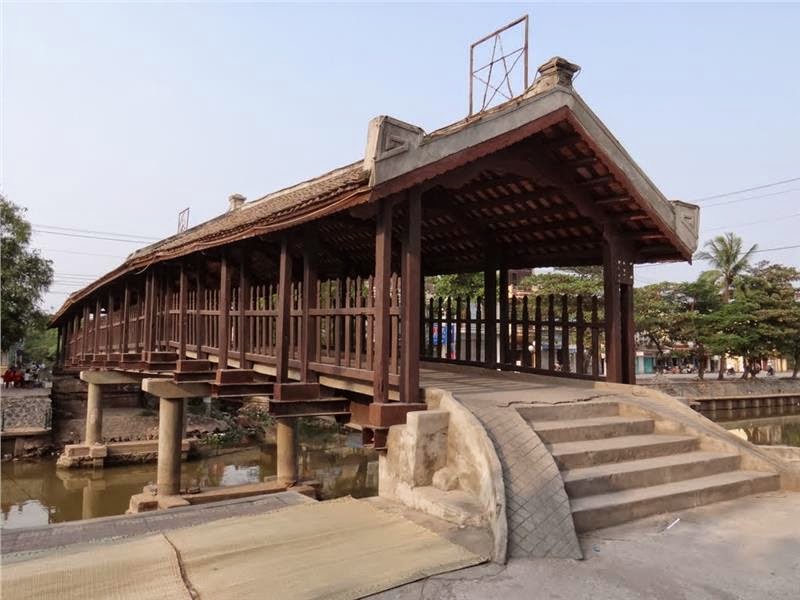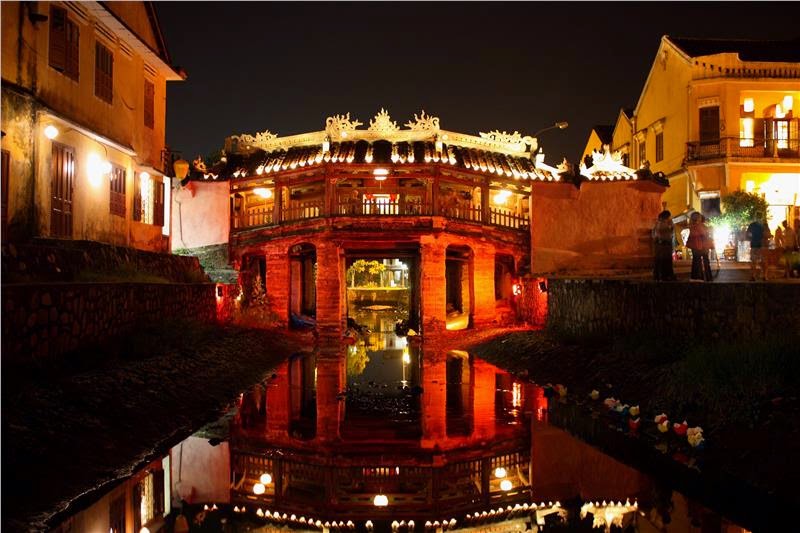Phat Diem tile roofed bridge, Ninh Binh
 |
| tile roofed bridge in Ninh Binh |
Along with Stone Cathedral, Phat Diem tile roofed bridge is one of unique folk architectural works in Kim Son, Ninh Binh. This is both the bridge undertaking the function of transportation and the ancient communal house close to the locals here. Far about 30km from Ninh Binh city center, the bridge is situated in the center of Phat Diem town across An River. Phat Diem tile roofed bridge is made of wood consisting of three spans with 4 compartments in each span. The bridge retains the total length of 36m and 3m wide. Two sides of the bridge are 2 rows of handrails and pillars made of ironwood. The bridge is covered with traditional red tiled roof. There are also flights of steps leading down the road and the river at both bridgeheads. Along with Phat Diem Stone Cathedral and Trang An tourist complex, Phat Diem tile roofed bridge is gradually becoming one of the indispensable tourist sites in Vietnam tour packages.
From a coastal swampy region, Kim Son district was listed on the map of Vietnam in 1829. Together with the establishment of the village, Nguyen Cong Tru constructed irrigation works. First of all, he allowed digging An River connecting Vac River with Can River to get fresh water. Digging the canals was conducted in parallel with building roads and dividing the boundaries. The tile roofed bridge was born in that situation. The bridge was built entirely with wood and tile roof in 1876. The floors of the bridge at that time were sheets of plywood 10 meters long which was connected with the bridge beams thanks to nails used on the boats. The bridge has been constantly reinforced and renovated to serve the needs of the locals as well as the main road to the sea... Over time, the wood floor of the bridge has been replaced. The 2 sides of the roads are pretty solidly concreted, yet the bridge with ancient and tranquil tile roofs is always the pride of the people in Kim Son. Phat Diem tile roofed bridge is worth one of the most impressive tourist attractions in Ninh Binh alluring tourists.
Thanh Toan tile roofed bridge, Hue
 |
| Thanh Toan Bridge |
Far about 8km from Hue city center by road to the east, the tile roofed bridge is cross the ditch flowing from the beginning to the end of Thanh Toan Village, Thuy Thanh commune, Huong Thuy district, Thua Thien - Hue province. Thanh Toan village was founded in the 16th century. The wooden bridge was built for the convenient transportation of the locals in the village. It is also home to temporary stop for tourists participating Hue travel. Thanh Toan tile roofed bridge was built under the architecture style of "house on the bridge" with 17m long and 4m wide. The bridge was covered with glazed tubular tiles and divided into 7 compartments.
Thanh Toan tile roofed bridge is the ancient architectural monuments retaining great values in terms of history, culture; simultaneously, it is an indispensable scenic sight in the journey of discovering Vietnamtours to Hue. The bridge was built over 2 centuries ago. Undergoing storms, floods and the juggernaut of war, the bridge still retains its unique form and architecture. In the spirit of "eating a fruit, thinking of the man who planted the tree" and respecting cultural heritages, many generations of villagers in Thanh Toan have preserved the unique architectural works in Hue. In particular, the bridge was greatly restored in original scale and officially recognized as a National Monument by Ministry of Culture - Information in September 1991. It has become a precious scenic sight in Hue tourism in particular and the country in general so far.
Japanese Covered Bridge - symbol of Hoi An
 |
| Japanese Bridge |
Japanese Covered Bridge, also known as Cau Pagoda - the common name for the architectural complex consists of a small pagoda mounting in the northern slopes of the ancient bridge in the urban area of Hoi An Ancient Town, Quang Nam province. The 18m long bridge with 7 wooden compartments crossing Hoai River (a tributary of Thu Bon River) connects Nguyen Thi Minh Khai Street with Tran Phu Street, Hoi An. The bridge retains the soft curved shape with the large number of beautiful motifs. Both bridge and pagoda are carved lacquer extremely meticulously. The pagoda overlooks towards the riverside. The pagoda is covered with yin-yang tiled roof covering whole bridge. It deserves one of the indispensable tourist addresses in the journey of discovering Hoi An travel attracting the great number of both domestic and international tourists.
Cau Pagoda is an architectural works constructed by Japanese traders in Hoi An in the early 17th century. The bridge is also called Lai Vien Kieu by Lord Nguyen Phuc Chu in his visit to Hoi An in 1719 with the implications willing to welcome tourists from over the world. The bridge is associated with the legend of mamazu - a kind of sea monster whose head was in India, body was in Vietnam and tail was in Japan. Whenever bestirring, the monster caused floods, earthquakes... Japanese Covered Bridge is considered as the sword astride on the back of the monster to keep the peaceful life. Not only retaining significance in terms of trading, Japanese Covered Bridge also owns architecture extremely unique strongly attracting tourists.
Although called the pagoda, inside the temple has no statue of Buddha. In the sanctum of the pagoda is home to worship the wooden statue of God Xuan Wu - Gods protecting the country, bestowing joy and happiness to people. With Hoi An people, Japanese Covered Bridge is the soul, the Hoi An symbol existing more than four centuries. Even though having gone at least six times of the restoration, Cau Pagoda still retains its original ancient features. It was recognized as a national level cultural historical relics in 1990. It is always the indispensable tourist attraction in Da Nang - Hoi An tour in Vietnam. Tourists going to Hoi An without visiting Japanese Covered Bridge are considered not setting foot on the beautiful and peaceful land. Along with other Vietnam tile roofed bridges, Japanese Covered Bridge displays its contribution in promoting Vietnamtourism closer to both domestic and international tourists.
ReplyDeletemáy bay eva air
may bay eva di my
ve may bay korean air
giá vé máy bay đi mỹ khứ hồi
mua vé máy bay đi canada
Nhung Chuyen Di Cuoc Doi
Ngau Hung Du Lich
Kien Thuc Du Lich